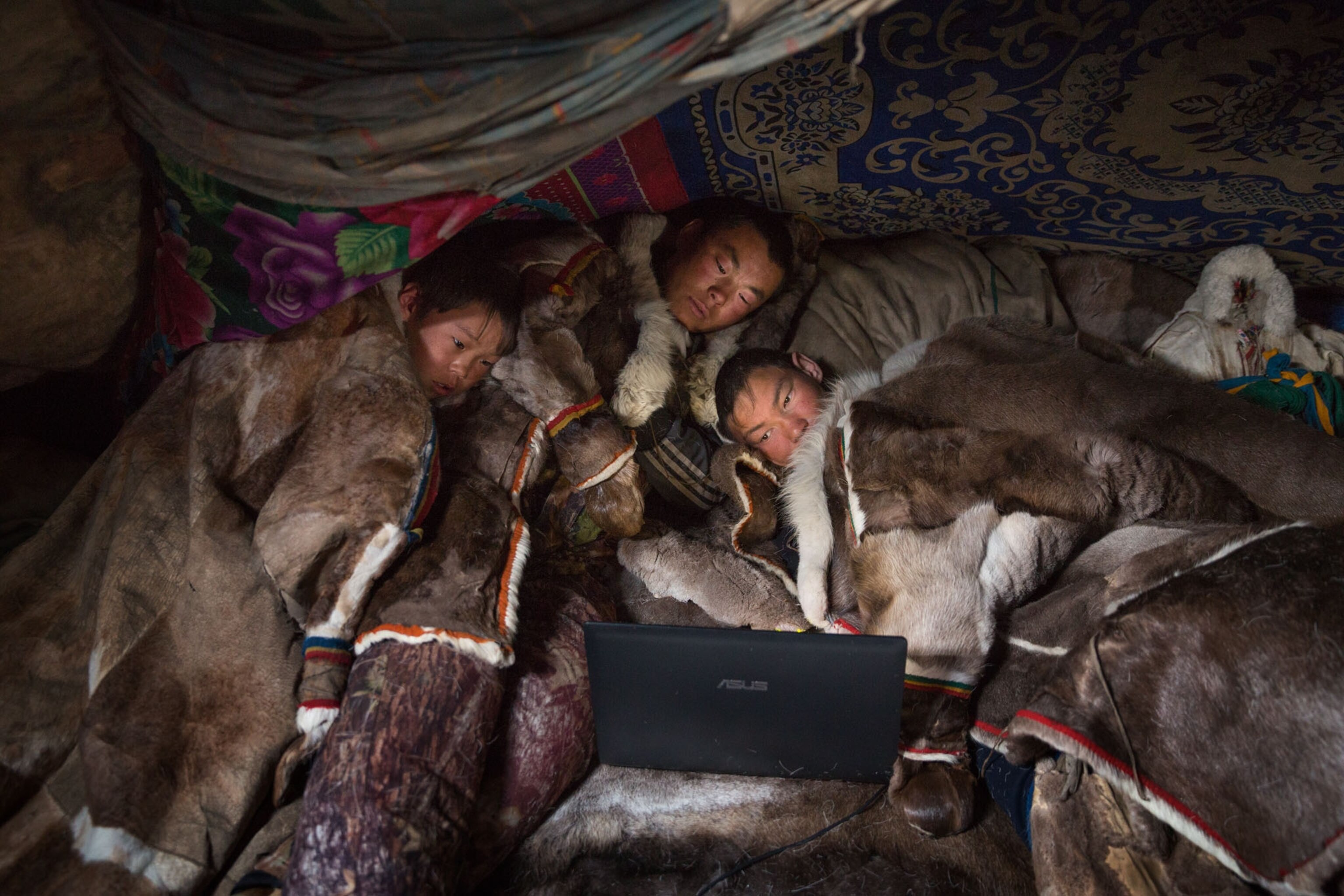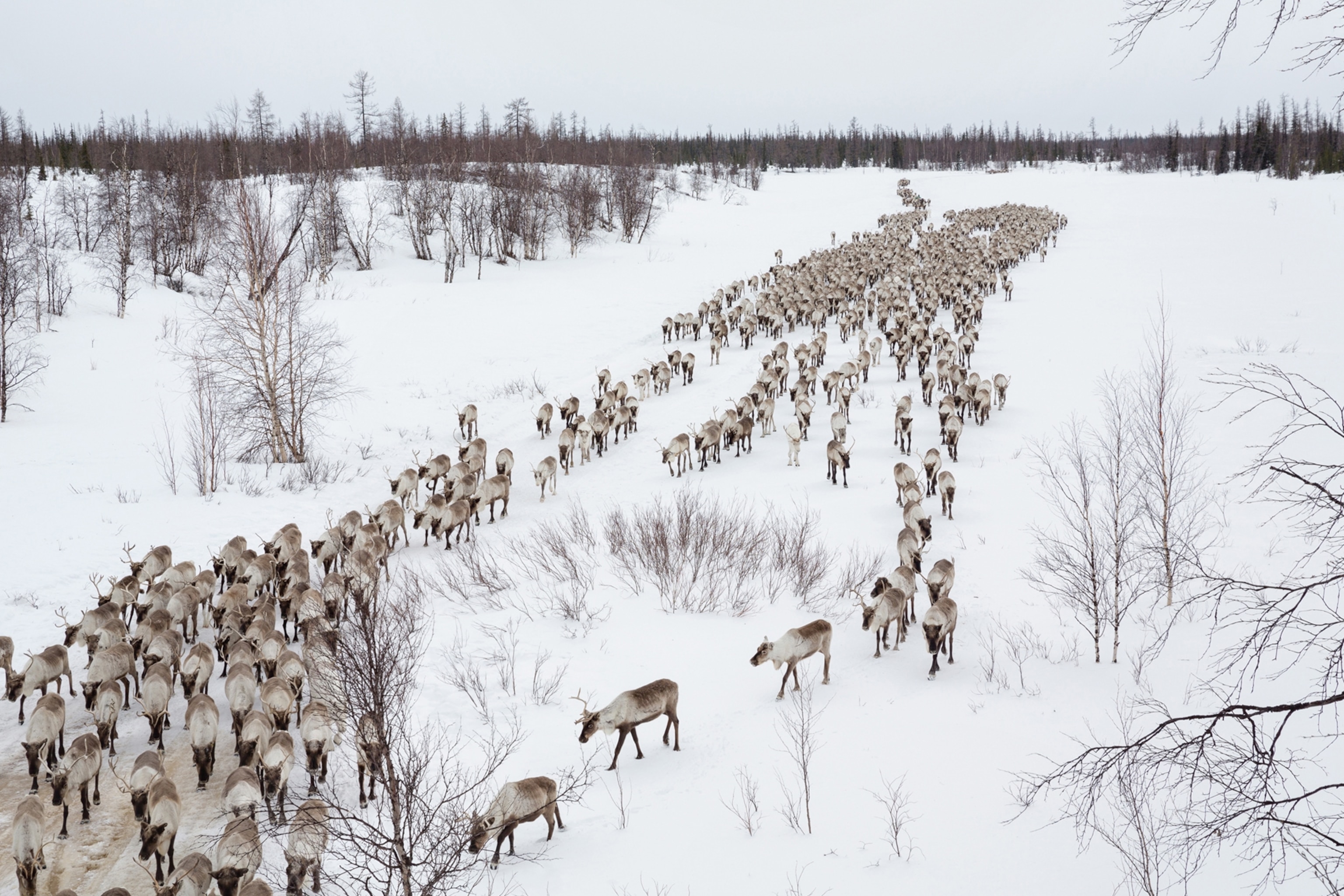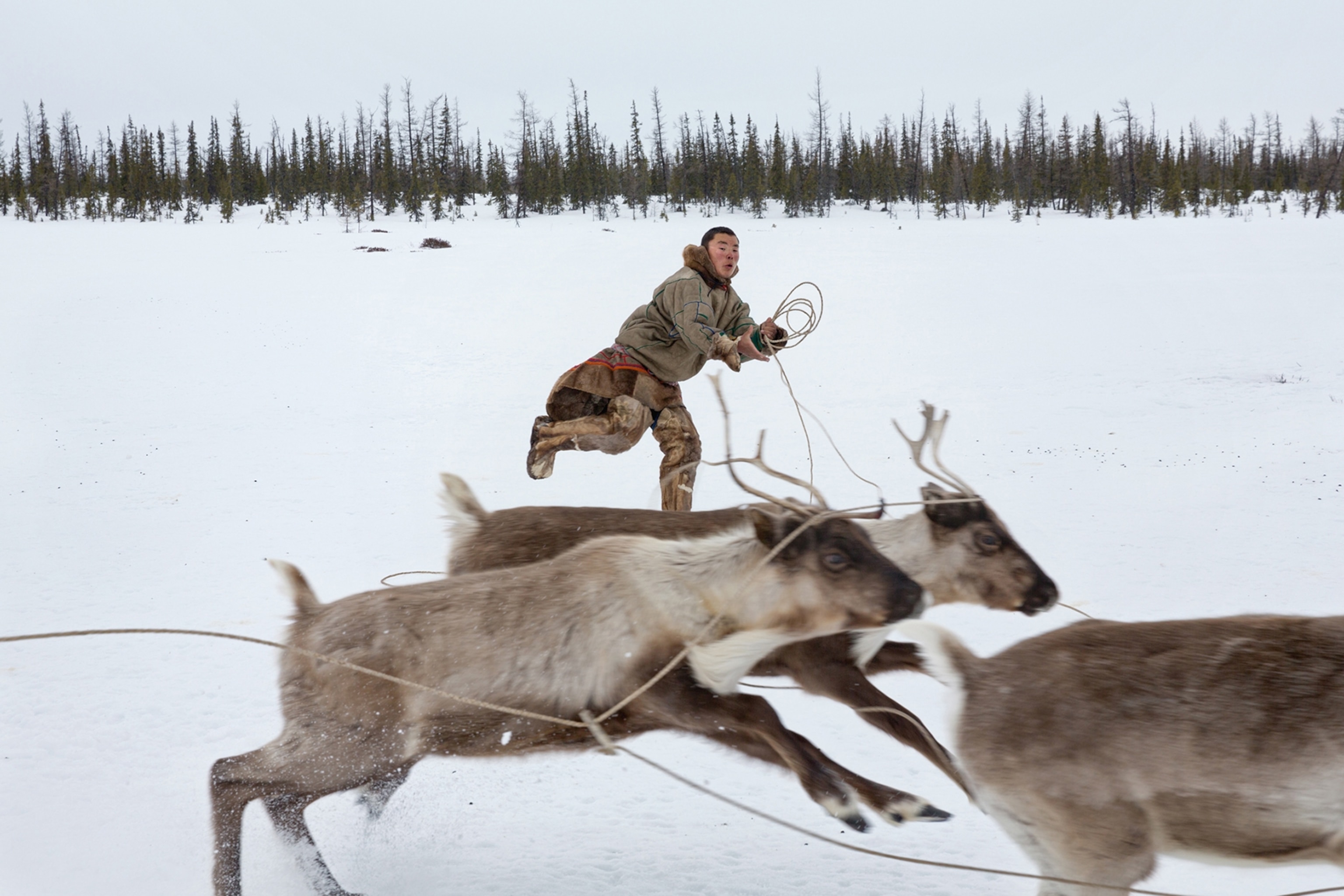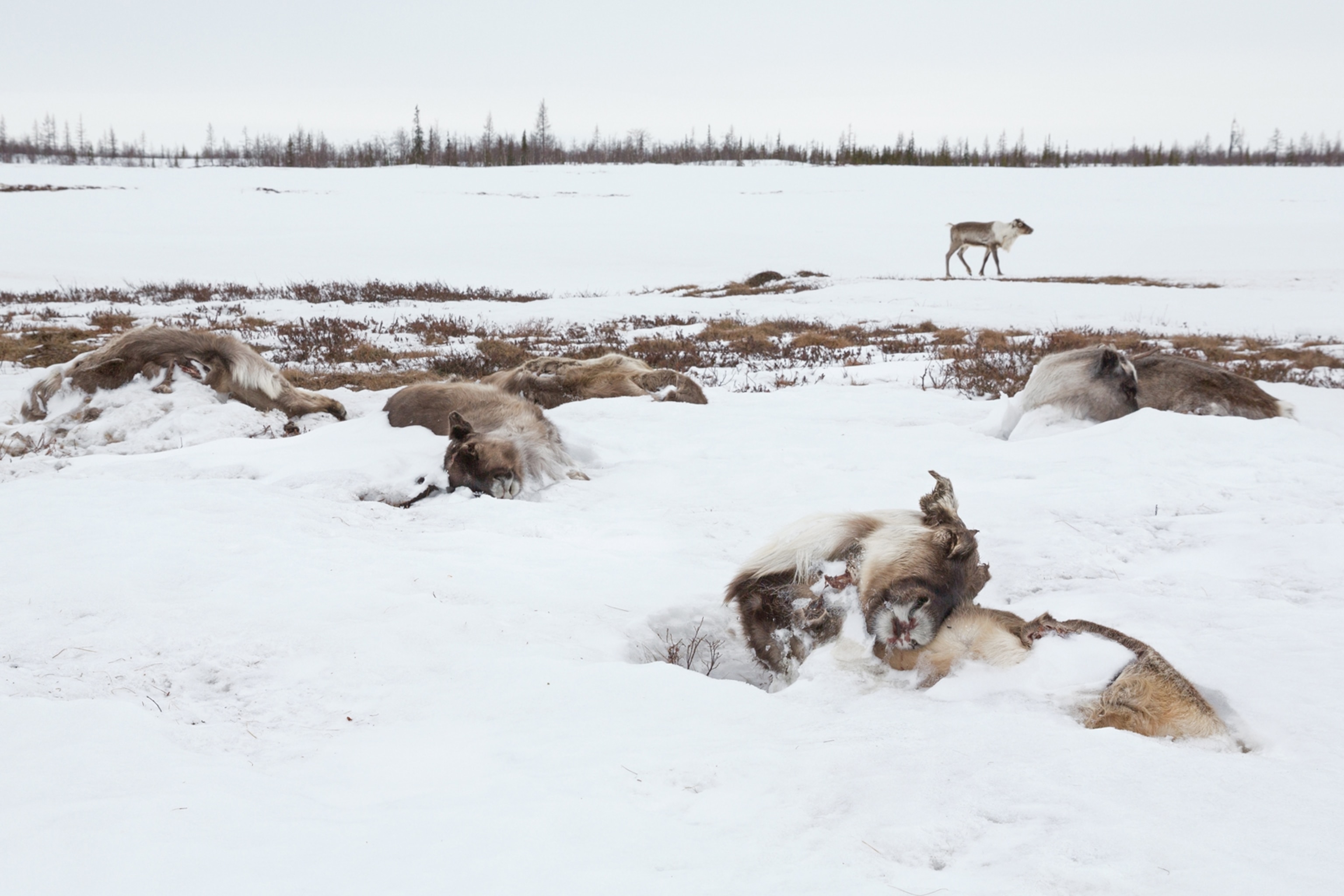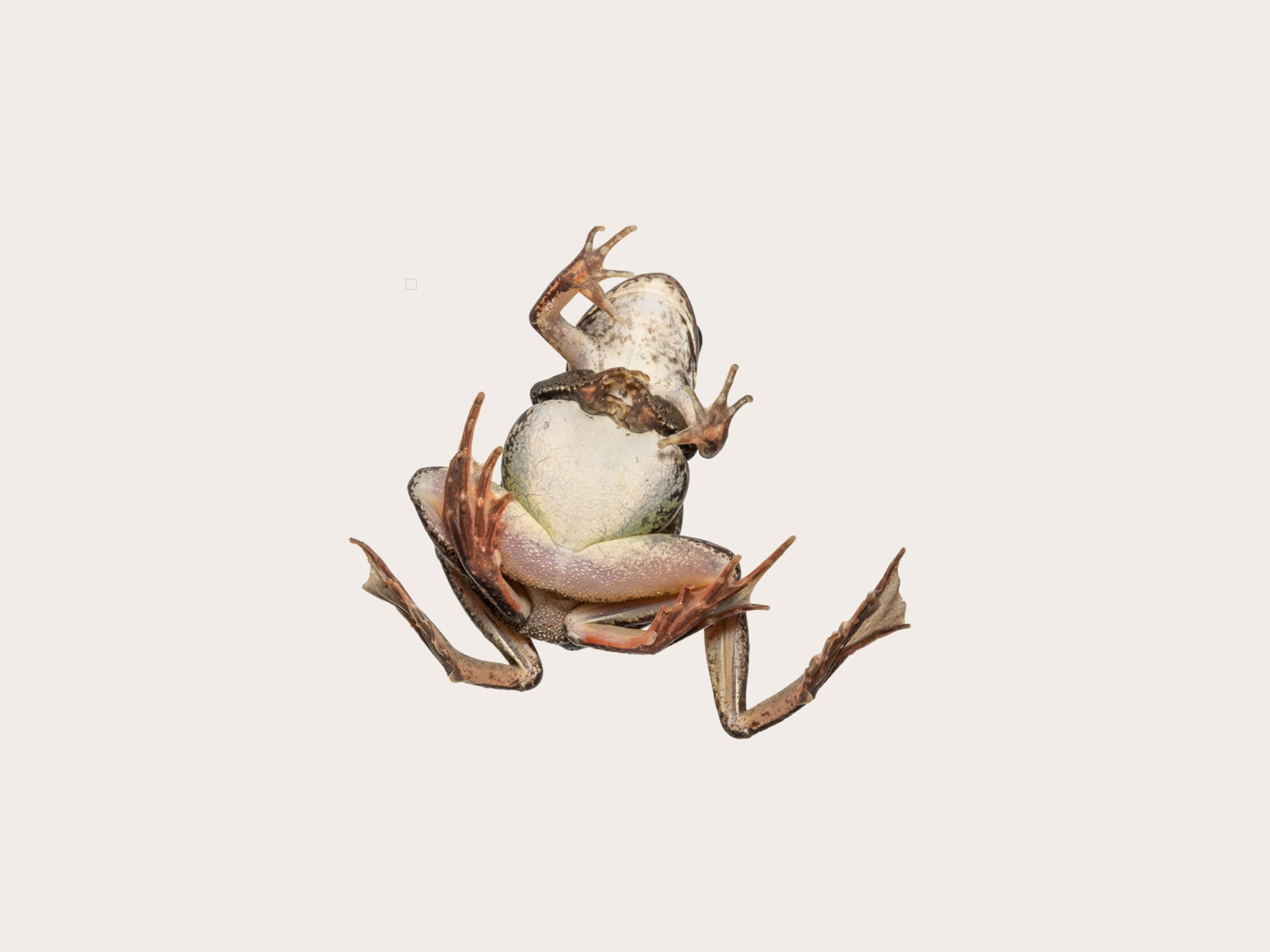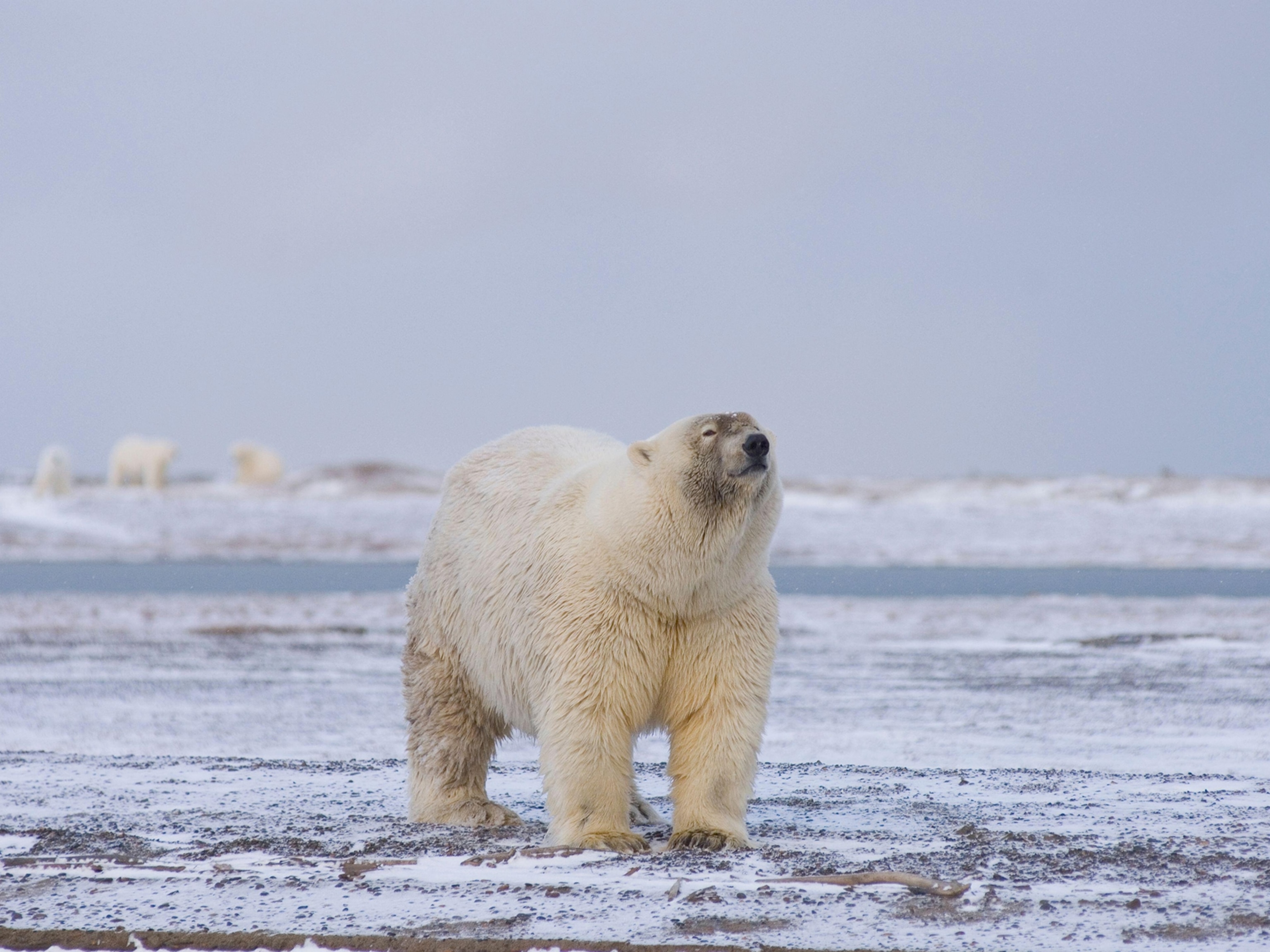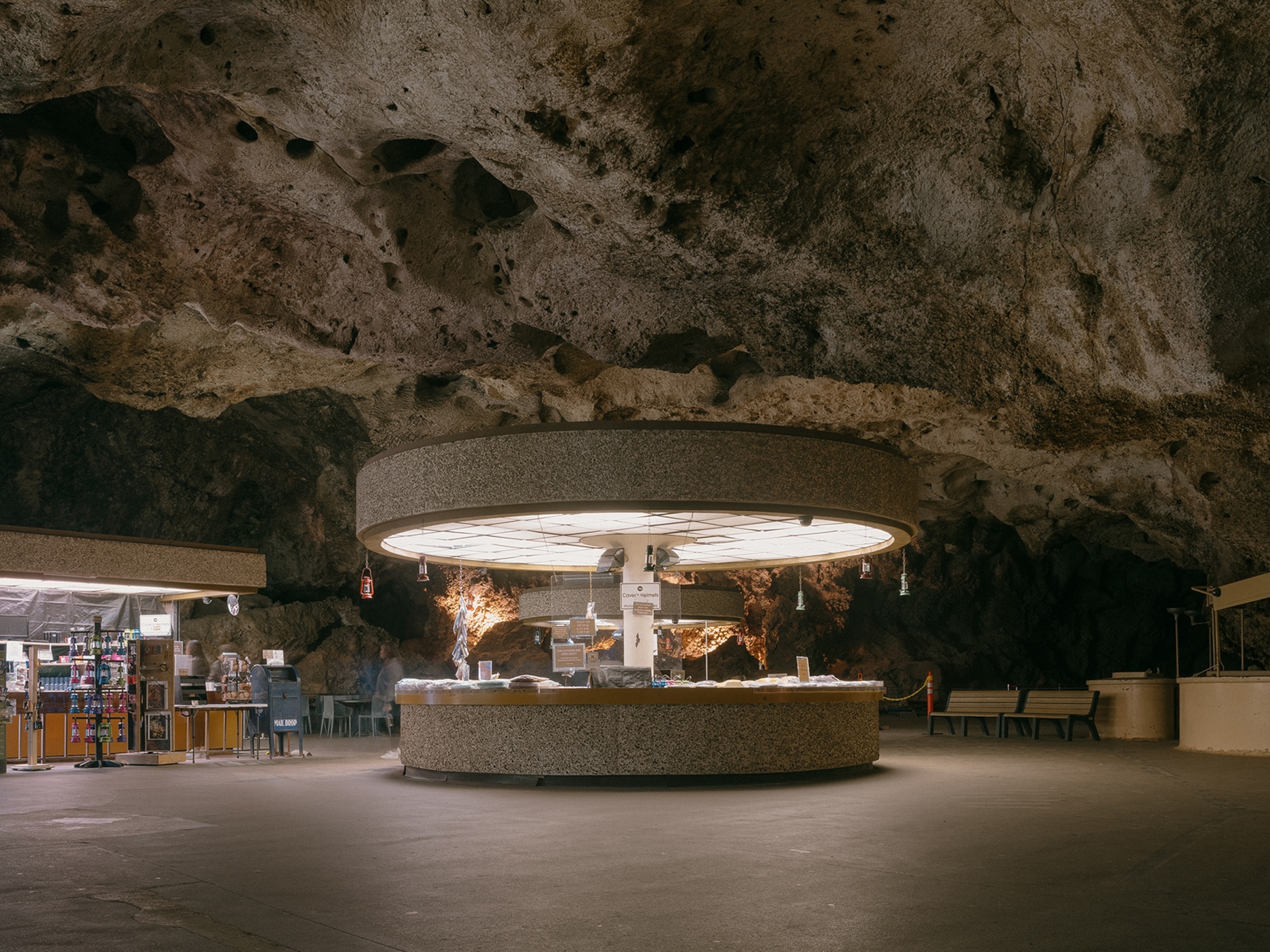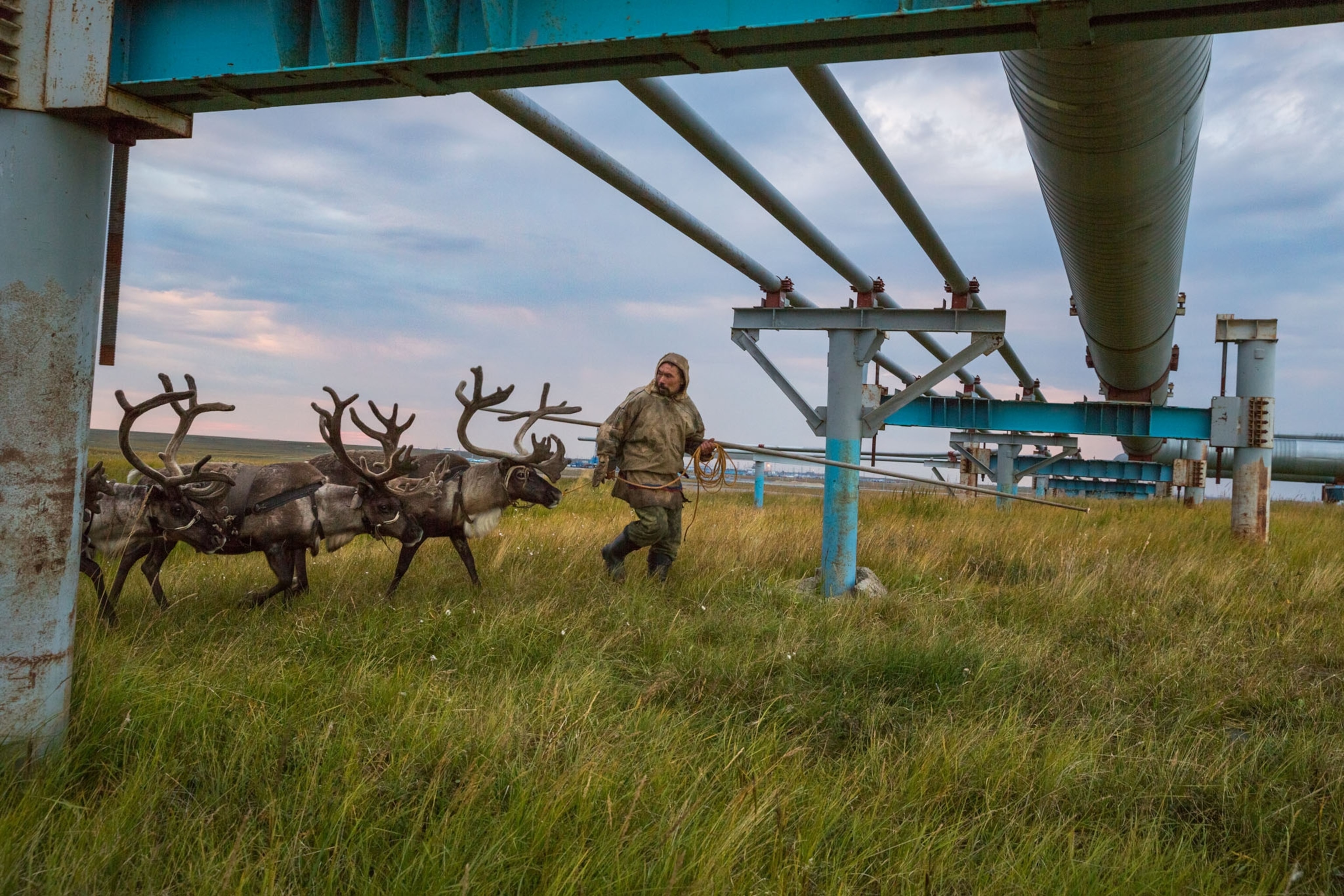
They Migrate 800 Miles a Year. Now It’s Getting Tougher.
The Nenets, reindeer herders in Russia’s Arctic, face modern obstacles in their long journey: climate change and a giant natural gas field.
Clad in a camouflage jacket, the mosquito netting unzipped from his hood, Yuri Khudi squats by the fire inside his large chum. Outside, seven more of the teepee-like tents cluster in a semicircle. Swells of Siberian tundra roll north toward the Arctic Ocean; a reindeer herd grazes on a distant crest. It’s mid-July, and the group of Nenets herders that Yuri leads are about halfway through an annual trek that takes them 400 miles north on the Yamal Peninsula to the Arctic coast—in normal years, that is.
“It’s been three years since we have made it all the way to our summer pastures by the Kara Sea,” Yuri says as his wife, Katya, pours him a steaming mug of tea. “Our reindeer were too weak for the long journey.” In the winter of 2013-14, an unusual warm spell brought rain to southern Yamal; the deep freeze that followed encased most of the winter pastures in thick ice. The reindeer, used to digging through snow to find lichen, their main winter food, couldn’t dig through the ice. In this herd and others, tens of thousands starved. Now, in the summer of 2016, the survivors are still recovering.
The canvas entrance of the chum flaps open, and a reindeer, antlers down, bursts inside. It pauses in front of the fire, shakes vigorously, and flops down to chew its cud meditatively.
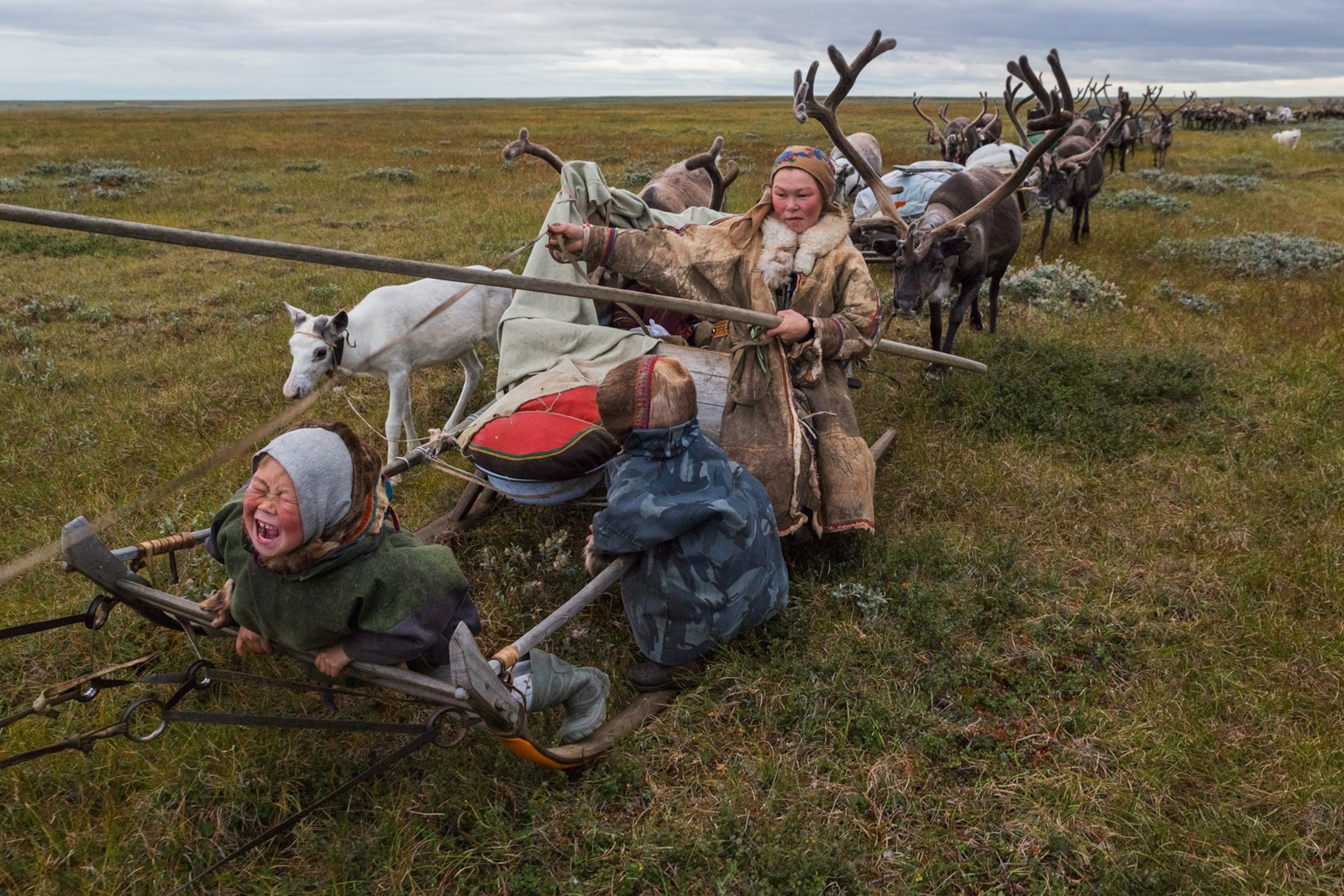
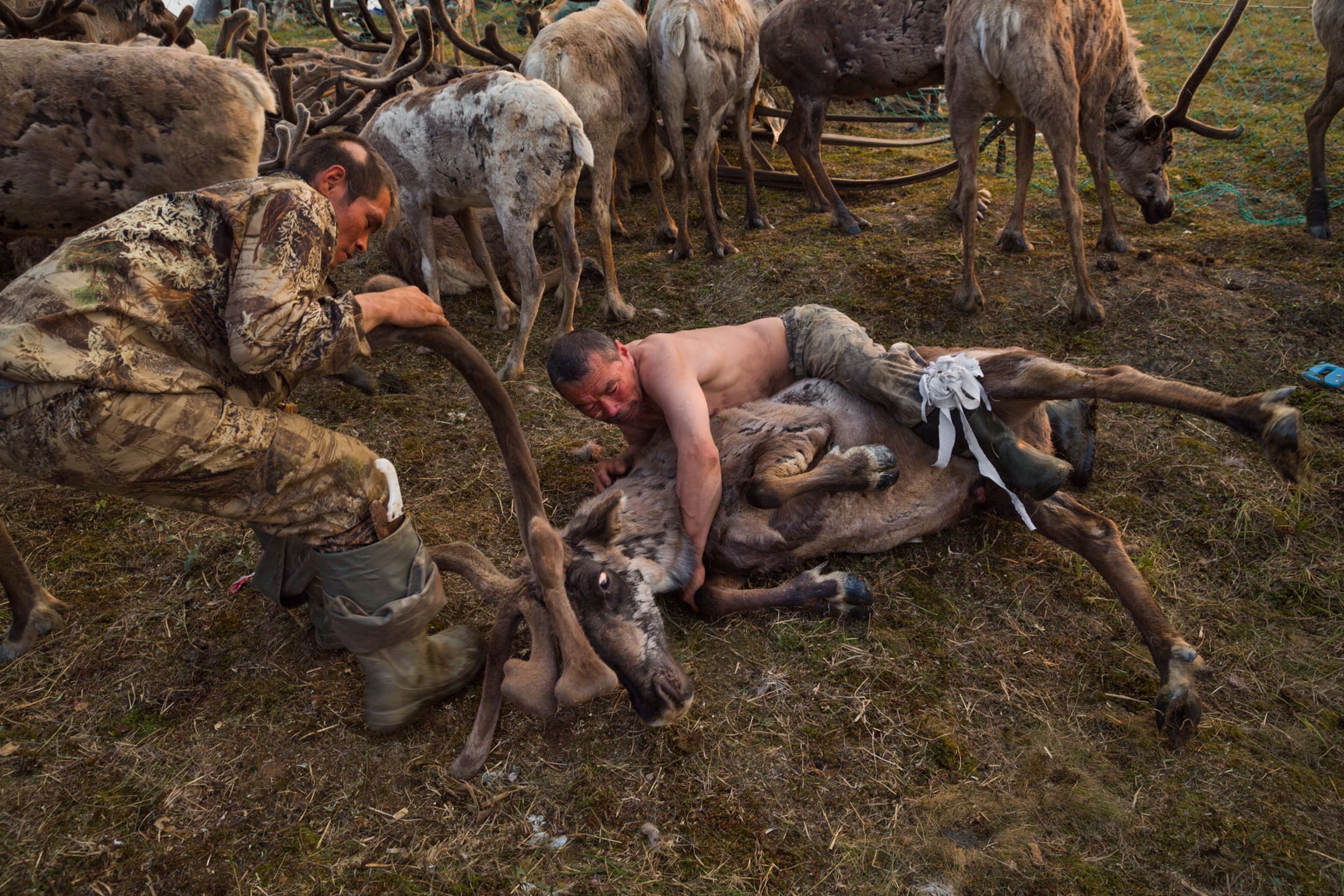
“This young cow lost her mom, so we raised her ourselves inside the chum,” explains Yuri, taking a cautious sip of tea. “She doesn’t like mosquitoes. Hopefully next year she’ll have a calf of her own. We’re down to about 3,000 reindeer now, half of our usual herd.”
The Nenets have undertaken this annual migration for centuries, and at 800 miles round-trip, it’s one of the longest in the world. Yuri’s group, called Brigade 4, is a relic of a Soviet collective—under Soviet rule the Nenets endured decades of forced collectivization and religious persecution. They survived centuries of Russian rule before that. Through it all, they’ve managed to sustain their language, their animist worldview, and their nomadic traditions.
“The Nenets are one of the most resilient indigenous groups in the Arctic,” says Bruce Forbes of the University of Lapland in Finland, a geographer who has studied them for decades.
Today, however, that resilience is being tested in new ways. Climate scientists say the kind of “rain on snow” event that diminished the herds three years ago will become more frequent and intense in the Arctic as the climate warms. As I talk to Yuri, the region is suffering another record-hot summer; the thermometer has already hit 94°F. It hasn’t rained for weeks, and it’s hard for reindeer to pull the loaded sleighs across the dry tundra. Before the summer is out, a boy and more than 2,300 reindeer will die from anthrax on southern Yamal, and dozens of people will get sick—a direct result of thawing permafrost, which allowed animal carcasses buried during an outbreak in the 1940s to reemerge, still bearing infectious microbes.
Yet climate change isn’t even the greatest threat to the Nenets. Development is. Russia’s quest for new sources of hydrocarbons has encroached on pastures that were already tight for the estimated 255,000 reindeer and the 6,000 nomadic herders that live on Yamal. And it has restricted the essential migration of some of the herds. The Bovanenkovo gas field, the largest on Yamal, sits directly in Brigade 4’s path. The herd must cross the field, with its roads and pipelines, to get to the summer pastures.
The Nenets have always lived close to the edge; in their language, Yamal means “edge of the world.” But these days at least some of them seem precariously close to falling off.
A Nenets Winter
Perched on the left side of the sleigh, his legs firmly planted on a runner, Nyadma Khudi raps the backs of his reindeer with a tyur—a long pole of polished wood ending in an antler knob. Grunting softly, he urges the four bulls forward through shrub willows and clouds of mosquitoes. Nyadma is Yuri’s elder brother and a former brigade chief. As a sign of respect, his caravan of several sleighs is in the lead as Brigade 4 presses on toward Bovanenkovo.
After about an hour, Nyadma suddenly stops. “We’ll break here for a bit, to let everybody catch up,” he says, as he fishes a ringing cell phone out of his capacious, bell-shaped reindeer-skin coat. Other sleighs pull up behind us. The harmony of clicking reindeer hooves soon gives way to the cacophony of dial tones and human chatter as the Nenets enjoy one of the few perks of having a mega-development in their backyard: We’re now within range of Bovanenkovo’s cell phone tower.
I step away from the sleighs to stretch my legs. The midnight sun fills the lakes and waterways ahead of us with an amber glow. A distant hum, like that of a jet before takeoff, draws my attention; it’s coming from the gas field, still many miles away.
Yamal’s natural gas is the cornerstone of Russia’s energy strategy—the new source that will replace declining fields to the south and east of here—and Bovanenkovo is the cornerstone of Yamal. It’s operated by Gazprom, the state-owned company that produces most of Russia’s natural gas and supplies more than a third of the European Union’s imports. According to Alexey Miller, Gazprom’s CEO, Yamal could produce as much as 13 trillion cubic feet of gas a year by 2030—more than a third of Russia’s projected total. Bovanenkovo alone has confirmed reserves of nearly 173 trillion cubic feet. Linked to the mainland by its own airport and a 350-mile railroad, and to Russia’s gas grid by two 750-mile pipelines, Bovanenkovo is also a launchpad for Gazprom’s further expansion into the Russian Arctic.
Global warming is the greatest obstacle to that ambitious agenda. Alexey Osokin is deputy director of Gazprom’s engineering center, which has collected and analyzed 25 years of weather and permafrost data from meteorological stations and gas wells around the Yamal Peninsula. “One cannot argue with the data,” he says. “There is no doubt that the climate is warming.” In summer, thawing permafrost undermines the stability of Gazprom structures. The company has had to install refrigeration units to keep the ground frozen around wellheads and pipelines.
Some effects of thawing permafrost are hard to prepare for, Osokin says. In the summer of 2014 a gaping crater, 130 feet wide by 115 feet deep, suddenly formed in the tundra 19 miles southeast of Bovanenkovo. Experts blame an eruption of methane gas that had been trapped under frozen ground. They worry that if a similar eruption were to occur under the gas field itself, it could cause considerable damage. In the summer of 2017 two more eruptions were reported on the peninsula. One occurred near the camp of a herder.

Brigade 4 has a deadline: a day and an hour when, by appointment with Gazprom, it is to cross the busiest road through Bovanenkovo. After two days of picking our way through an industrial maze, we finally reach the crossing place. On the concrete road, large trucks roll by every minute. Crossing is treacherous for both reindeer and herders.
“This is why we coordinate the road crossings with Gazprom,” says Galina Mataras, director of a nongovernmental organization that represents the Nenets herders. “It’s taken a lot of time and effort to make sure that the crossing is expedient and safe.” At the appointed hour, traffic is stopped and a large swath of white geotextile fabric is unrolled across the road. The fabric eases the movement of sleighs across the concrete slabs.
For Gazprom the “white carpet” affair is an annual photo opportunity. A helicopter has flown in from Salekhard to deliver representatives of the company, the herders’ own business enterprise, a couple of NGOs, the regional government, and the local press. As the reindeer caravan begins the crossing, Gazprom and the press document the event. Workers in crisp blue coveralls, with a silver Gazprom logo branded on their backs, line up on both sides of the white carpet to take pictures and get selfies with the herd.

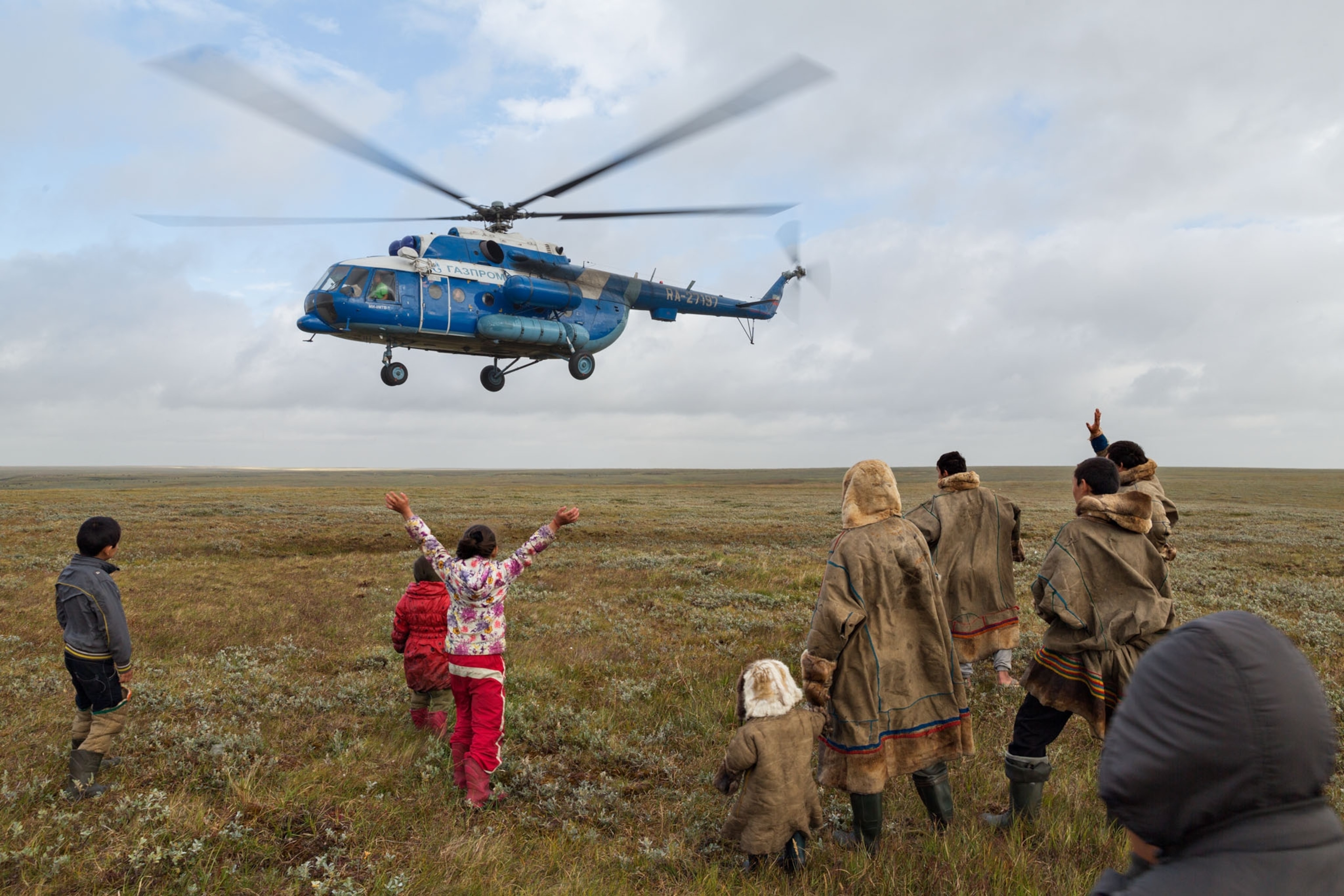
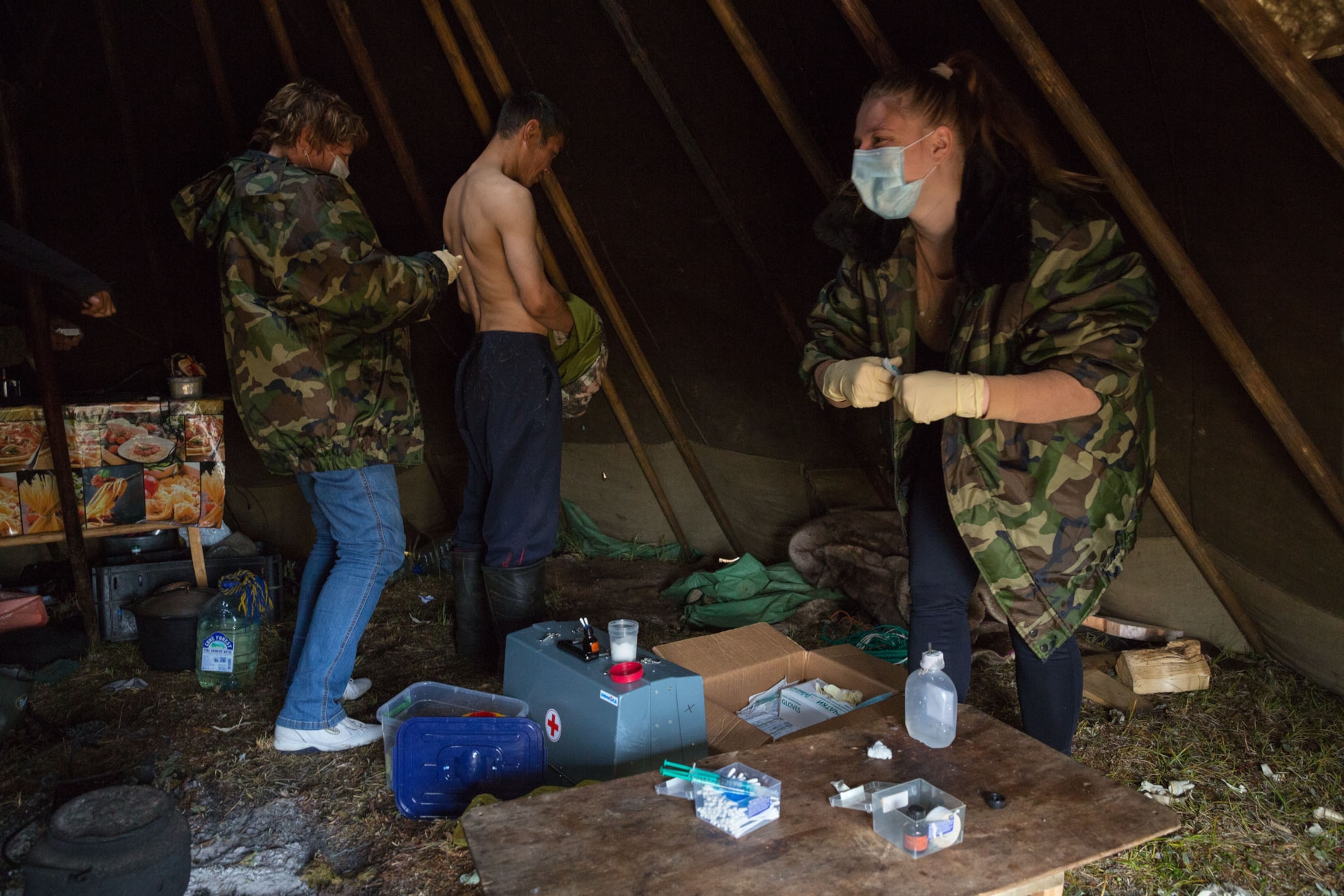
“That’s it!” announces Nyadma, after we’ve crossed the road at last. “No more roads or pipelines. We don’t have to rush and break camp every night now. We can take our time fishing.
“It wasn’t easy, when Gazprom arrived,” he goes on. In the early years at Bovanenkovo, after construction began in the 1980s, rail lines, pipelines, roads, sandpits, and buildings were popping up everywhere. “We felt trapped, like there was no place for us on our ancestral land,” Nyadma says. “We understand that the country needs natural gas, and once the main construction stopped, we figured a way around this mess. We can cope with it.” He pauses. “As long as they don’t build any more roads or pipelines.”
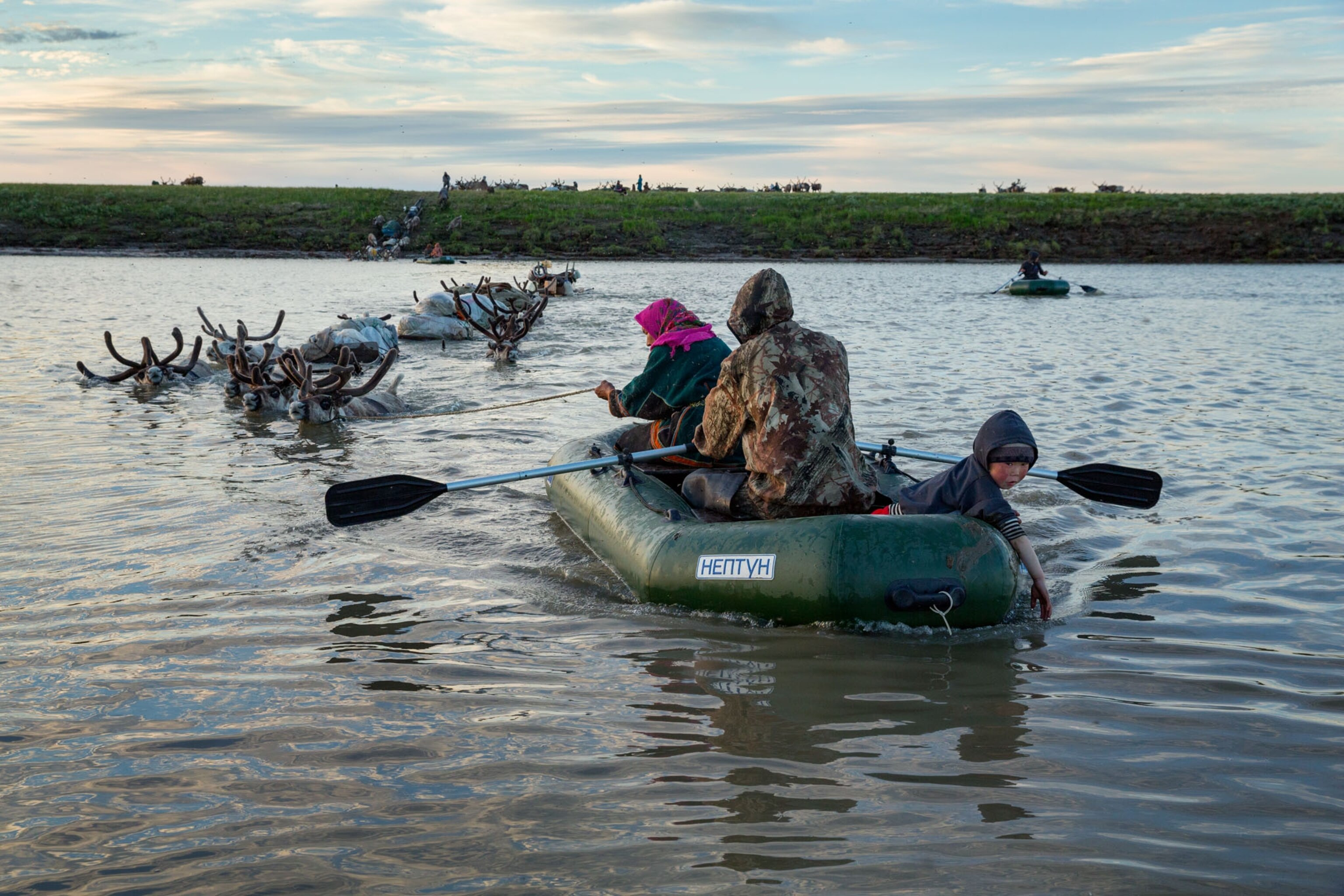
An hour later we stop on a high knoll, and Nyadma peers through his field glasses, scouting the pass ahead. His sons Gosha and Ilya pull up in their sleighs. Now everybody is looking in the same direction through their binoculars, talking agitatedly in Nenets. In the distance a new dirt road scars the tundra.
Later we discover a new feeder line parallel to the road; connecting a gas well to a compressor, it cut across our next campsite. Neither the road nor the pipe were here three summers ago, when the brigade last passed through. The Nenets hadn’t been alerted to their construction. They shouldn’t be there, Nyadma says.

At the campsite, between the road and the pipeline, I discover the source of the distant hum I heard a few days ago. Just a few hundred yards away now, it’s a crimson ball of fire belching out of a sooty pipe—a gas flare that serves to release excess pressure from the pipeline. In the swirling air around the flames, tundra, water, and sky melt into a mirage of browns, greens, and blues. The hum has become a powerful roar that drowns out most other sounds.
And from this vantage point, the notion that the Nenets reindeer herders can coexist in a “balanced” way with oil and gas development—an idea I heard consistently from Gazprom officials, the regional government, NGOs, and the herders themselves—seems an illusion. A new gas processing facility, with its associated roads and pipelines, is scheduled to come on line at Bovanenkovo in the next couple of years. Two new railroad branches are being constructed to connect hubs at Bovanenkovo and Payuta in western Yamal with oil and gas terminals on the east coast. Those railway lines will cut across the migration routes of most of the Nenets herds. Even more troubling for Brigade 4, a new gas field called Kruzenshternskoye is projected to come on line in the early 2020s on the Kara Sea coast. It will encroach on exceptionally rich pastures.
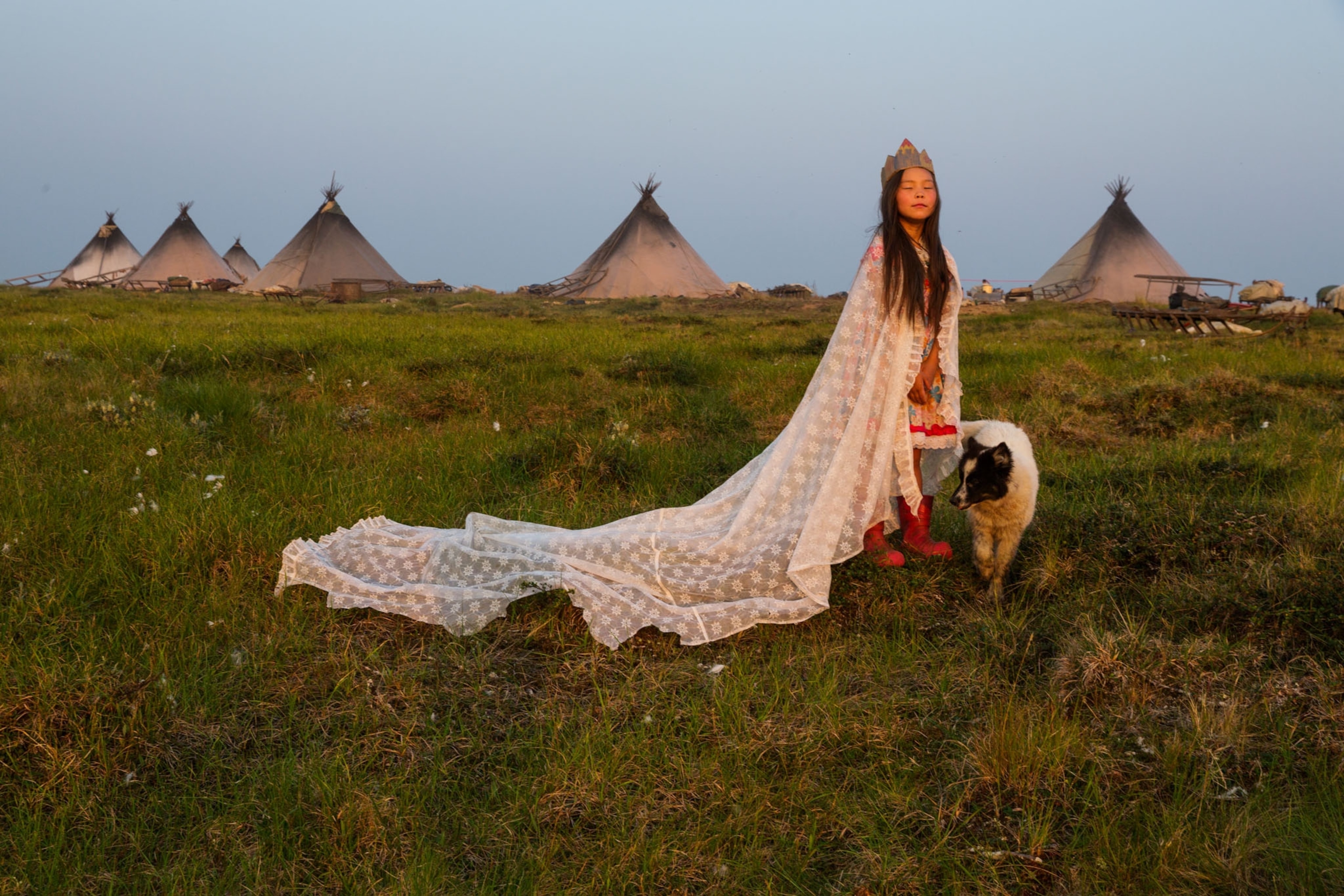
As I’m pondering all this, the roaring gas flare abruptly shuts off. The thermals dissipate around the pipe, and the landscape beyond settles back into its familiar shapes and colors. Around me, the next generation of Nenets herders are practicing their lassoing skills on sleighs, dogs, and each other, while the next generation of Nenets mothers feed their dolls in makeshift toy chums. In the silence, the familiar sounds return—the low voices of the herders, the cries of the children and dogs, the clicks of the reindeer hooves. For a moment, everything seems all right again on the edge of the world.


